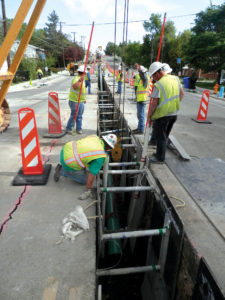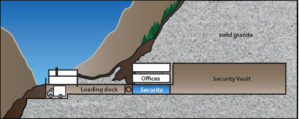
The complexities of the built environment continually challenge the limits of engineering and construction. For infrastructure built-in areas with settlement-prone soils or other hazardous geological conditions, assembling a team of experts to plan for challenges is essential. Industries like mining, oil and gas, and utilities must often bore through earth and rock to build tunnels, pipelines and conduits (Figure 1). In areas with unstable geological conditions, this work becomes increasingly dangerous, both during construction and in everyday use. Likewise, builders across the country must account for settling soils, eroding embankments and wet environments. Owners, builders and designers facing these challenges have often relied on geofoam.
Building a foundation on top of mining tunnels
In 2012 a confidential mining company wanted to erect a storage building above an existing set of mining tunnels in the rocky Wasatch Range outside of Salina, Utah, 140 miles (225 km) south of Salt Lake City. The tunnels, which were an average of 12 feet (3.66 m) below grade, were used for beltlines and trucks hauling equipment, people, and materials in and out of the mines. During design, structural calculations revealed that the existing tunnels would not support the weight of the new storage building.
“Mining situations are particularly critical for a lot of reasons,” said Terry Meier, geofoam specialist with ACH Foam Technologies.
Meier worked with the design engineering firm to identify the best solution for the project. After looking at micropile and grade-beam structural systems, the team determined the fastest and easiest solution would be to build an expanded polystyrene (EPS) geofoam base as a platform for the new building above the tunnels (Figure 2).
“We created a structural barrier between the tunnels and the building,” said Meier. The barrier consisted of 28,000 cubic feet (792.87 m3) of EPS geofoam installed 8-feet (2.44-m) deep and 80-feet (24.38-m) long in two layers. A 6-foot (1.83-m) deep and 50-foot (15.24-m) long section was stacked directly above the tunnel, followed by a 6-inch (15-cm) concrete load distribution slab to support the storage building, effectively eliminating structural impacts to the tunnels below.

Rockfall protection at a vault entrance
A project in the mountains of Little Cottonwood Canyon outside of Salt Lake City, Utah, presented a completely different challenge. Like the threat of structural collapse, the dangers of rockfall are well understood in mining work where tunnels enter a sheer rockwall or steep cliff. In the case of the Little Cottonwood Canyon site, a vault built inside a mountain of solid granite, the entrance to the vault was itself vulnerable to rocks falling from above.
“The vault’s entrance is located at the base of a large rock face,” Meier said. “Even a rock a few inches wide tumbling down and smashing into the building entrance could result in structural damage.”
Meier worked with the construction company to build a protective barrier above the entrance made from geofoam. Together, they developed a dense layer of protection, which is up to 15-feet (4.57-m) thick in areas with the highest probability of rockfall. A geogrid material was placed between each layer of geofoam and covered with a 6-inch (15-cm) layer of gravel and a 12-inch (30-cm) layer of soil. This geofoam cushion works in conjunction with the building’s 20-inch (51-cm) thick reinforced-concrete roof to protect the entrance from the impact of a boulder with a diameter as large as 36 inches (91 cm) falling from a distance of 60 feet (18.29 m) (Figure 3).
“Our role is to help engineers and builders understand the properties of EPS geofoam and then tackle their specific challenges,” said Meier.
Protecting an overhang from falling rocks and a tunnel from structural collapse are two very different mining engineering challenges. Technical guidance helps to ensure engineers are selecting grades that meet specific structural requirements and that geofoam blocks are configured efficiently to eliminate waste.

Geofoam for a natural gas pipeline
Another geological hazard is the seismic threat present in much of Utah.
“Gas lines, utilities, pipes or anything that has to be buried can be catastrophically damaged in the event of an earthquake,” said Meier.
Utility provider Questar Gas distributes natural gas to more than 900,000 customers in Utah, southwestern Wyoming and a small portion of Idaho. Developing pipeline projects in some of these areas requires the utility’s engineering team to account for unstable conditions including quaternary fault lines where pipelines are especially vulnerable. As a result, the utility provider’s engineering guidelines require that sections of pipeline traversing known fault lines be encased in geofoam for protection (Figure 4).
In the spring of 2014, a contractor installed 14,000 cubic feet (396.44 m3) of geofoam to encase a gas pipeline as it passed along a fault. The precut geofoam blocks were wrapped in a protective geomembrane and then placed in the pipe trench to form a protective cushion around the pipe. A 12-inch (30-cm) flowable fill cap was placed above the geofoam and directly below the asphalt. This simple solution to a complex problem with potentially serious consequences not only provided the utility with assurance that the pipeline is protected but also saved time and money.

Meier and colleagues are not alone in their work, often teaming up with specialized EPS engineering consultant Marvin Cook of Oracle Engineering in Utah. A veteran geofoam designer of more than 20 years, Cook consults with owners, engineers, contractors and ACH Foam Technologies to solve large-scale highway and bridge infrastructure challenges.
“The importance of the block configuration in the design can’t be overstated,” said Cook.
“Obviously, I look for critical flaws in the planned design that could lead to structural weaknesses,” said Cook. “But there are more specific issues to be aware of, as well. We are always on-site during installation to make sure everything is accounted for.”
Cook also said that, in his experience, geofoam tends to be selected for its reliable performance and low-cost constructibility.
“The proven performance of EPS geofoam ensures that you can put it in the ground today and 50 years from now it will be the same basic material with no real degradation,” Cook said.
Conclusion
In each of these situations, Meier credited collaboration and a willingness to explore possibilities with finding the most appropriate solution to each challenge.
“Geological hazards come in all shapes and sizes,” said Meier. “It’s exciting to continually push toward the horizon and help owners, builders and designers resolve complex problems with simple solutions.”
 TEXTILES.ORG
TEXTILES.ORG



That’s so interesting how geofoam works! I imagine that it has multiple uses and might come in handy in other places besides the western US. I wonder when it will be available to independent companies trying to prevent rockfalls.